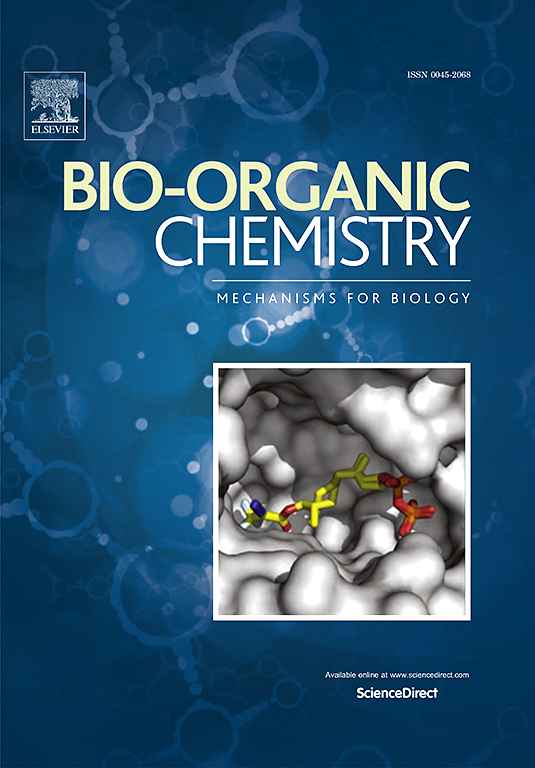一种新的靶向PARP-1肿瘤成像的68ga标记niraparib衍生物的合成和生物评价。
IF 4.5
2区 医学
Q1 BIOCHEMISTRY & MOLECULAR BIOLOGY
引用次数: 0
摘要
聚 ADP 核糖聚合酶(PARP)抑制剂能阻止同源重组异常的癌细胞修复 DNA 单链断裂,产生合成致死效应。因此,PARP 抑制剂已成为临床上有效的抗癌药物。用放射性核素标记PARP抑制剂可作为示踪剂用于核医学诊断,帮助对患者进行分层。本研究选择尼拉帕利作为骨架分子,用1,4,7,10-四氮杂环十二烷-1,4,7,10-四乙酸(DOTA)修饰,并用镓-68标记,得到放射化学纯度高(>95%)的[68Ga]Ga-DOTANPB。为了验证[68Ga]Ga-DOTANPB结构的准确性,还合成了[natGa]Ga-DOTANPB,并进行了体外亲和实验,结果表明它对PARP-1具有很高的亲和力(IC50 = 82.21 nM)。[在体外实验中,[68Ga]Ga-DOTANPB 在 HeLa 细胞中有很高的摄取率,能进入细胞内靶向 PARP-1。在对罹患 HeLa 肿瘤的小鼠进行冠状 PET 成像时,[68Ga]Ga-DOTANPB 在 0.5 小时、1 小时和 2 小时后在肿瘤部位显示出明显的放射性浓度。生物分布和自显影实验显示,[68Ga]Ga-DOTANPB具有明显的肿瘤摄取作用,并能被显著抑制(3.37 ± 0.33 % ID/g vs. 2.50 ± 0.27 % ID/g,**P < 0.01),这表明它具有PARP-1特异性。因此,这些研究结果表明,[68Ga]Ga-DOTANPB可能是一种潜在的基于尼拉帕利的PET示踪剂,用于靶向PARP-1。本文章由计算机程序翻译,如有差异,请以英文原文为准。

Synthesis and bioevaluation of a new 68Ga-labelled niraparib derivative that targets PARP-1 for tumour imaging
Poly ADP-ribose polymerase (PARP) inhibitors prevent the repair of DNA single-strand breaks in cancer cells with abnormal homologous recombination, producing a synthetic lethal effect. Thus, PARP inhibitors have become clinically effective anticancer drugs. Labelling with radionuclides may extend the use of PARP inhibitors as tracers in nuclear medicine diagnostics, helping to stratify patients. In the present study, niraparib was selected as a skeleton molecule modified with 1,4,7,10-tetraazacyclododecane-1,4,7,10-tetraacetic acid (DOTA) and labelled with gallium-68 to obtain [68Ga]Ga-DOTANPB with high radiochemical purity (>95 %). To verify the accuracy of the [68Ga]Ga-DOTANPB structure, [natGa]Ga-DOTANPB was also synthesized, and in vitro affinity experiments were performed, which revealed a high affinity for PARP-1 (IC50 = 82.21 nM). [68Ga]Ga-DOTANPB is hydrophilic and has good in vitro stability within 3 h. In in vitro experiments, [68Ga]Ga-DOTANPB has a high uptake in HeLa cells and can enter the cell to target PARP-1. In coronal PET imaging of HeLa tumour-bearing mice, [68Ga]Ga-DOTANPB showed significant radioconcentration at the tumour site at 0.5 h, 1 h, and 2 h. Biodistribution and autoradiography experiments revealed that [68Ga]Ga-DOTANPB has obvious tumour uptake and can be significantly inhibited (3.37 ± 0.33 % ID/g vs. 2.50 ± 0.27 % ID/g, **P < 0.01), suggesting that it has PARP-1 specificity. Thus, these findings suggested that [68Ga]Ga-DOTANPB may be a potential niraparib-based PET tracer for targeting PARP-1.
求助全文
通过发布文献求助,成功后即可免费获取论文全文。
去求助
来源期刊

Bioorganic Chemistry
生物-生化与分子生物学
CiteScore
9.70
自引率
3.90%
发文量
679
审稿时长
31 days
期刊介绍:
Bioorganic Chemistry publishes research that addresses biological questions at the molecular level, using organic chemistry and principles of physical organic chemistry. The scope of the journal covers a range of topics at the organic chemistry-biology interface, including: enzyme catalysis, biotransformation and enzyme inhibition; nucleic acids chemistry; medicinal chemistry; natural product chemistry, natural product synthesis and natural product biosynthesis; antimicrobial agents; lipid and peptide chemistry; biophysical chemistry; biological probes; bio-orthogonal chemistry and biomimetic chemistry.
For manuscripts dealing with synthetic bioactive compounds, the Journal requires that the molecular target of the compounds described must be known, and must be demonstrated experimentally in the manuscript. For studies involving natural products, if the molecular target is unknown, some data beyond simple cell-based toxicity studies to provide insight into the mechanism of action is required. Studies supported by molecular docking are welcome, but must be supported by experimental data. The Journal does not consider manuscripts that are purely theoretical or computational in nature.
The Journal publishes regular articles, short communications and reviews. Reviews are normally invited by Editors or Editorial Board members. Authors of unsolicited reviews should first contact an Editor or Editorial Board member to determine whether the proposed article is within the scope of the Journal.
 求助内容:
求助内容: 应助结果提醒方式:
应助结果提醒方式:


